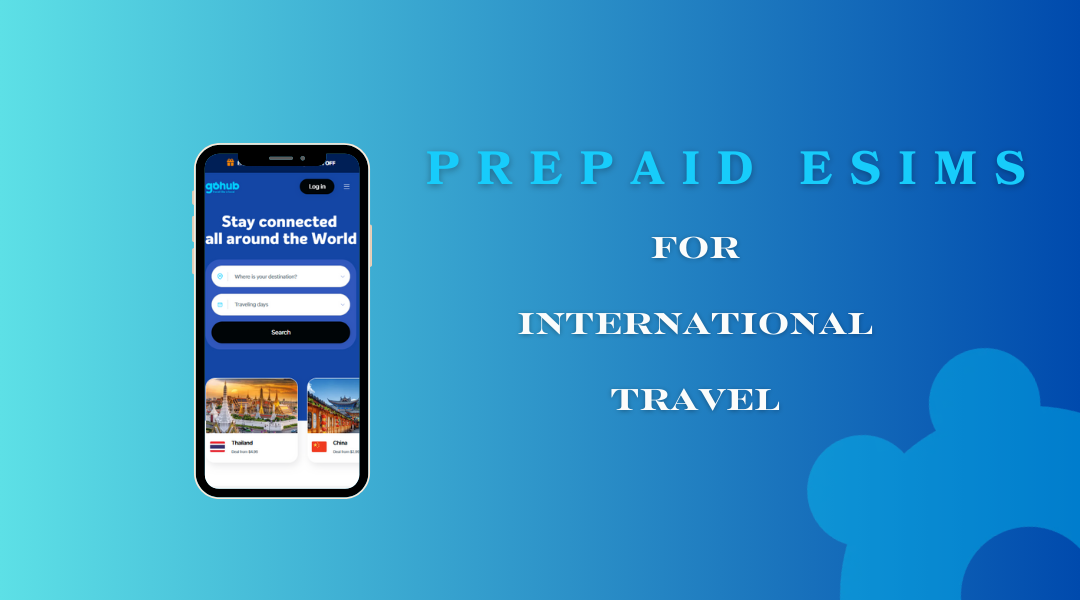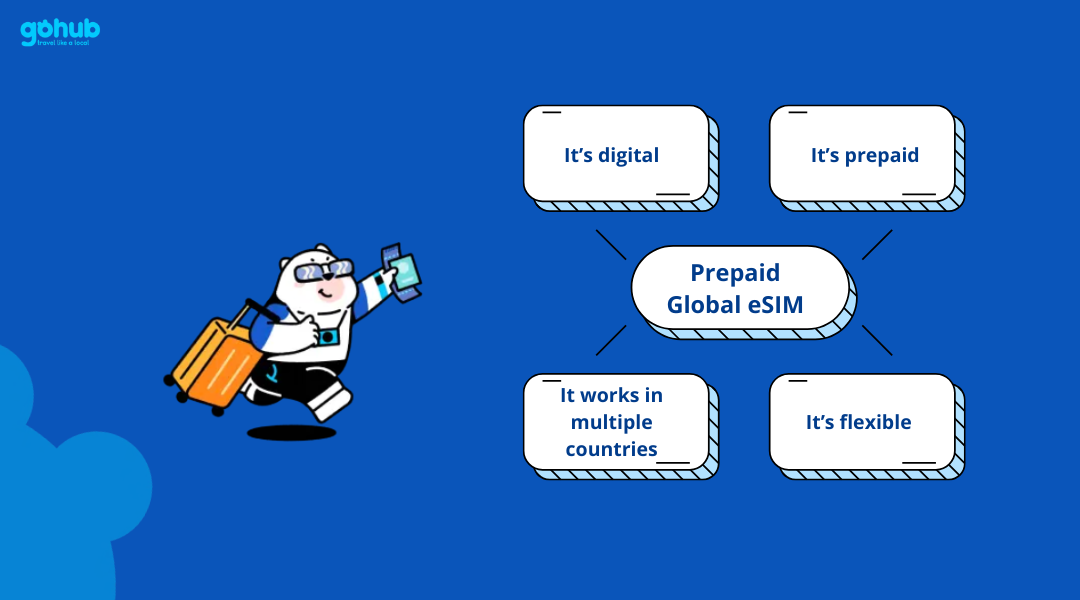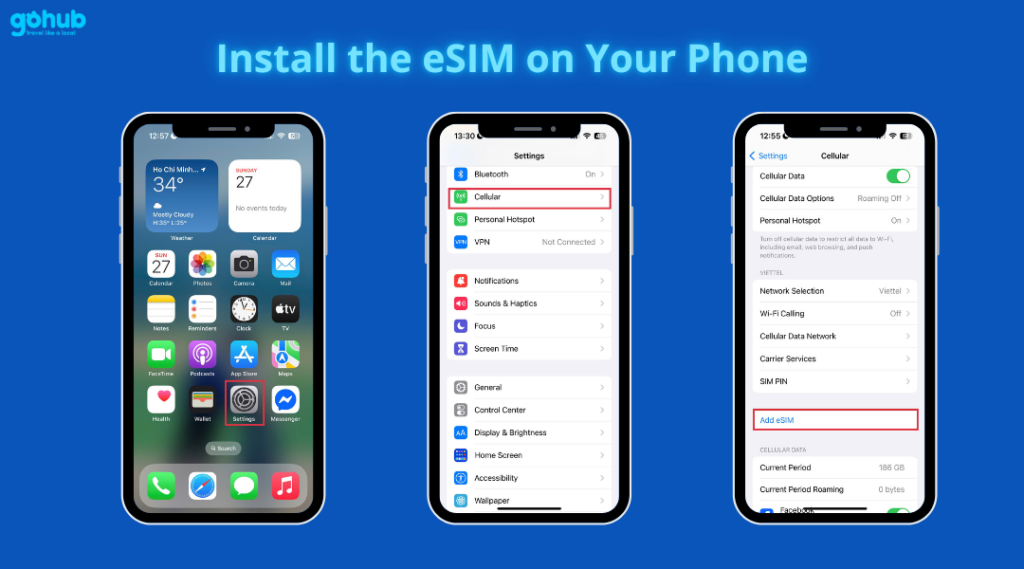You know that feeling when you’ve just landed after a 10-hour flight, your phone switches to roaming mode, and suddenly… bam — no data, no signal, no idea how to get to your hotel?

Yeah. Been there. And let’s be honest: scrambling to find a SIM card at the airport, or relying on flaky Wi-Fi in a foreign café, is not exactly the kind of adventure we dream of.
That’s why more and more travelers — from solo backpackers to business nomads — are switching to prepaid global eSIMs.
A prepaid eSIM gives you mobile data across multiple countries without the mess of contracts, SIM swaps, or surprise roaming charges. It’s digital, flexible, and ridiculously convenient. Just scan a QR code, activate the plan, and you’re online — even before you leave the airport.
In this guide, we’re diving into everything you need to know about prepaid eSIMs for international travel: what they are, how they work, who they’re best for, and how to find the best-value options that won’t eat up your travel budget. Whether you’re a frequent flier or a first-time wanderer, this is your roadmap to hassle-free global connectivity — no contracts, no roaming stress, just pure freedom.
I. So, What Exactly Is a Prepaid Global eSIM (And Why Should You Care)?
Let’s break it down — no tech jargon, just real talk.
A prepaid global eSIM is like your passport to mobile data, minus the plastic and the paperwork. Instead of buying a physical SIM card for each country you visit (and digging through your backpack to find the tiny SIM tool you definitely lost), you just download a digital SIM profile onto your phone — and boom, you’re connected.
Here’s what makes a prepaid eSIM different (and frankly, better) than the old-school way of staying connected abroad:
- It’s digital: No need to insert or swap anything. You just scan a QR code or install it via an app.
- It’s prepaid: You choose how much data you want before your trip. No contracts. No hidden fees. No surprise $500 phone bill when you get home.
- It works in multiple countries: A global or regional eSIM covers you in dozens (sometimes 100+) countries — perfect if you’re hopping between destinations or don’t want to keep switching providers.
- It’s flexible: Use it only when you travel. Turn it on, turn it off, top it up — all from your phone.
Let’s say you’re flying from New York to Bangkok, then doing a quick hop to Bali and Vietnam. With a prepaid global eSIM, you don’t need to buy three different SIMs, or rely on dodgy airport Wi-Fi. One plan. One install. Full coverage.
How does it work?
Once you buy your plan online, your provider (like GOHUB 😉) sends you a QR code. You scan it, download the eSIM profile to your phone, and activate it either before you fly or once you land. It uses local partner networks in each country to connect you — automatically.
Most modern phones (iPhone XS or newer, recent Samsung and Pixel models) support eSIM. And if your phone has dual-SIM, you can keep your regular number active while using the eSIM for data. It’s like having two phones in one — minus the bulk.

II. Why Prepaid Global eSIMs Are a Game-Changer for Modern Travelers
Let’s be honest — staying connected while traveling used to be a hot mess.
Between outrageous roaming fees, confusing local SIMs, language barriers at phone shops, and “free” airport Wi-Fi that never really works, most of us have dealt with some form of connectivity chaos abroad.
But with prepaid global eSIMs, that era is officially over.
Here’s why travelers everywhere — from digital nomads to weekend wanderers — are making the switch:
1. No More Roaming Bill Surprises
We’ve all been there: come home from a dream trip, open your phone bill, and almost faint. Roaming can cost $10–$15 per day with some carriers — and that’s not including video calls or last-minute Netflix downloads in hotel lobbies.
With a prepaid eSIM, what you pay is what you get. You choose a data package upfront, no sneaky fees or scary surprises. Use 5GB? You know exactly what that cost. Done.
2. Instant Connectivity — From the Moment You Land
One of the biggest perks of a global eSIM? You’re online as soon as the plane’s wheels hit the tarmac.
No more:
- Waiting in line at SIM kiosks
- Struggling to translate “I need internet”
- Asking strangers for Wi-Fi passwords
You can check Google Maps, call your Grab, or post that “I made it!” story before you even reach baggage claim.
3. One eSIM. Multiple Countries. Total Freedom.
If you’re traveling across several countries — say, Thailand → Vietnam → Singapore — the last thing you want is to buy and swap a different SIM for each one.
A prepaid global eSIM lets you roam freely across borders with one single plan. Some cover entire regions (like Southeast Asia or Europe), others work in 100+ countries. Just switch your eSIM “on” and let it do the magic.
4. Keep Your Main Number Active
Thanks to dual SIM support, you don’t have to choose between being online or reachable. Keep your home number active for calls and texts (or OTP codes!) while using the eSIM for local data. Bonus: WhatsApp still works like a charm, even with a data-only eSIM.
5. Flexible, Prepaid, No Contracts
There’s no commitment, no paperwork, no stress. Just pay-as-you-go simplicity.
Whether you need 1GB for a quick weekend escape or unlimited data for a month of digital nomad life, prepaid eSIMs let you pick what works — and change it whenever you want.
TL;DR: Why Travelers Are Ditching SIM Cards for eSIMs
| Old Way | New Way (Prepaid Global eSIM) |
|---|---|
| Physical SIM swapping | One digital install |
| Long lines at airports | Online setup in 2 mins |
| Daily roaming fees | Flat prepaid rate |
| One country only | 100+ country coverage |
| Language barriers | App-based, in your language |
Prepaid global eSIMs aren’t just a convenient tech upgrade — they’re a complete mindset shift for how we travel. Less logistics. More exploring.
In the next section, we’ll break down how to choose the best prepaid eSIM for your trip — and what to look for (besides just price). Because not all eSIMs are created equal.
III. How to Choose the Best Prepaid Global eSIM Plan for Your Trip
With so many eSIM providers out there, picking the right plan can feel like booking a flight during peak season — overwhelming, slightly stressful, and full of hidden fees if you’re not careful.
But don’t worry. Here’s your simple roadmap to choosing the best prepaid global eSIM — based on your trip, not just fancy marketing.
1. Know Where You’re Going (Seriously)
Are you traveling to:
- Just one country (e.g. Japan only)?
- A region (like Southeast Asia or Europe)?
- Or multiple continents (hello digital nomads!)?
Some eSIMs only cover one country. Others offer regional or global coverage — which is perfect if you’re hopping between destinations. Always double-check the list of supported countries before buying.
2. Estimate Your Data Needs
Think about how you use your phone while traveling. Here’s a rough guide:
| Activity | Average Data Use |
|---|---|
| Google Maps | ~5MB/hour |
| Social Media | ~50MB/hour |
| Browsing/Emails | ~60MB/hour |
| Zoom Call | ~800MB/hour |
| Netflix HD | ~3–4GB/hour 😬 |
If you’re just checking maps and messages → 3–5GB might be enough.
If you’re uploading vlogs or working remotely → 10–20GB (or unlimited) is safer.
Pro tip: Some “unlimited” plans slow down after a certain usage cap — read the fine print!
3. Don’t Just Compare Prices — Compare Value
Cheap isn’t always cheerful. When comparing plans, look at:
- Cost per GB (some plans charge $10/GB, others just $2–$3)
- Validity period (is it 7 days or 30?)
- Top-up options (can you add more data later?)
- Network partners (are they working with major carriers or no-name networks?)
- Does it support hotspot/tethering?
A $15 plan that actually connects you in 3 countries at 4G speed is better than a $10 one that barely loads your email.
4. Make Sure It’s Easy to Install and Use
The last thing you want when landing in a new country is to fumble through tech issues. Pick a provider that offers:
- QR code activation or 1-tap install via app
- Clear setup instructions (preferably in your language!)
- A mobile app to track usage and top-up easily
- Responsive customer support in case things go sideways
5. Match the Plan to Your Travel Style
| You Are… | You Need… |
|---|---|
| A backpacker hopping countries | A regional or global plan that lasts weeks |
| A short-term traveler | A local plan with lower data, shorter validity |
| A digital nomad | A flexible eSIM with top-up, hotspot, 5G |
| A family traveler | Multiple installs or data sharing options |
Bonus: Look for Brands That Offer Real Support (Not Just Cheap Data)
Because let’s be honest — when you’re standing in a night market in Bangkok with no connection and no clue, a real human on chat support > a chatbot that says “please wait 48 hours.”
Providers like GOHUB pride themselves on real, multilingual, 24/7 customer support. And when you’re abroad, that makes a world of difference.
Up next: We’ll compare popular eSIM providers — including GOHUB — to help you see who’s really offering the best value for global travel in 2025. Let’s find your perfect match.
IV. Comparing the Top Prepaid Global eSIM Providers (And Why GOHUB Leads on Value)
The prepaid eSIM market is full of options. From big players like Airalo to niche names like Nomad or GlobaleSIM, there’s no shortage of choices. But not all eSIMs are created equal — and depending on your travel style, some work better than others.
Here’s a side-by-side look at the most popular global eSIM providers in 2025 — and how GOHUB stacks up.
📊 Quick Comparison Table
| Provider | Strengths | Best For |
|---|---|---|
| Airalo | Huge country list, sleek app, flexible plans | Travelers wanting wide coverage |
| Nomad | Budget-friendly, good UI, regional options | Short-term travelers or minimal users |
| GlobaleSIM | Offers local phone number, some unlimited options | Users needing voice + data |
| Holafly | Unlimited data in key countries, WhatsApp works well | High data users, social addicts |
| GOHUB | 50% cheaper than big brands, 24/7 real human support, easy setup, multi-language app | Value-driven travelers who want simplicity & support |
Why Travelers Are Choosing GOHUB
Let’s be real: when you’re traveling across countries, you need more than just data — you need reliability, ease, and someone to call when things go sideways. GOHUB was built with that exact mindset:
Better Value (for Real)
While others charge $10–12/GB, GOHUB’s prepaid global eSIMs are often up to 50% cheaper — without sacrificing speed or coverage. You get top-tier partner networks, not budget backbones.
Simpler Setup
Buy. Scan QR. Connect. That’s it.
No complicated app maze or techy setup steps. Even your non-techy uncle could activate it in under 2 minutes.
Real Human Support (24/7)
Lost your connection in Seoul at 2 AM? GOHUB’s multilingual support team is ready — no bots, no canned replies, just a real person who helps you fix it fast.
Local Travel Experience Layer
GOHUB doesn’t just get you online — we also share authentic local travel tips in-app, curated from real travelers. Because beyond the internet, you want real connection too.
Bottom Line?
If you’re the kind of traveler who values:
- Transparent pricing
- Simple setup
- Coverage in 100+ countries
- Real support when it matters
Then GOHUB isn’t just another eSIM provider — it’s the smartest travel decision you’ll make this year.
Next up, we’ll walk you through how to buy, install, and activate your prepaid eSIM in just a few minutes — no tech stress required.
V. How to Buy, Install & Activate Your Prepaid Global eSIM (In 5 Minutes or Less)
So you’ve found the perfect prepaid global eSIM plan — now what?
The good news: setting it up is shockingly easy. No tech degree required. No SIM ejector pin. No running to a phone shop. Just a few taps and a Wi-Fi connection.
Here’s the step-by-step guide to getting connected fast:
Step 1: Buy Your eSIM Online
Head to your chosen provider’s website or app (👋 hi GOHUB!) and:
- Select your destination(s)
- Choose your data plan
- Enter your email and complete payment
📧 Right after checkout, you’ll receive a QR code or instructions via email.
Step 2: Install the eSIM on Your Phone
You’ll need Wi-Fi for this part. Here’s how it works by device:
For iPhone:
- Go to Settings → Cellular → Add eSIM (or “Add Cellular Plan”)
- Choose Use QR Code
- Scan the code sent to your email
- Follow the prompts — it takes 1–2 minutes

For Android (Pixel/Samsung):
- Go to Settings → Network & Internet → SIMs or Mobile Network → Add eSIM
- Select Download a SIM instead
- Scan your QR code
- Confirm and install
Once installed, you can give it a label like “GOHUB Asia” or “Europe Trip” so it’s easy to manage.
Step 3: Activate and Connect
Most prepaid global eSIMs activate automatically once you land and connect to a supported network.
When you arrive:
- Go to Settings → Cellular / Mobile Data
- Make sure your eSIM line is turned on
- Set it as your default for mobile data
- Toggle Data Roaming ON for the eSIM (and OFF for your main SIM to avoid charges)
🧠 Pro tip: Turn off Wi-Fi for a moment to make sure the eSIM kicks in. You should see 4G/5G signal within seconds.
Need to Top-Up or Extend?
Easy! Just:
- Open the provider’s app (or log in via website)
- Choose your plan → Top up or add data
- No need to reinstall — your eSIM stays in place
With GOHUB, you can track usage, extend plans, or even switch regions — all in one place, in your own language.

TL;DR: Setup in 3 Steps
- Buy your eSIM online
- Scan the QR code and install
- Activate when you arrive & turn on data roaming
You’re now ready to roam free — no contracts, no SIM swapping, no stress. Just you, your phone, and the open road (with Google Maps that actually loads).
👉 Up next: A few quick tips to manage your eSIM like a pro while traveling, and avoid the most common mistakes first-timers make. Let’s keep you connected like a champ.
VI. Staying Connected on the Go – Pro Tips & Common eSIM Fixes
Now that your prepaid global eSIM is up and running, let’s make sure it stays that way — smooth, fast, and stress-free.
Here are some tips to get the most out of your eSIM while traveling, plus easy fixes for the most common hiccups:
1. Track Your Data Like a Travel Ninja
Most eSIM apps (like GOHUB’s) let you see exactly how much data you’ve used.
Check it regularly — especially if you’re:
- Uploading reels from Mount Fuji
- Joining Zoom calls in a café in Lisbon
- Or letting the kids watch Netflix on your hotspot
Pro tip: Set alerts or limits in your phone settings to avoid sudden “data drought” moments mid-trip.
2. Need More Data? Top Up in Seconds
No need to reinstall anything — just open your app or login on the provider’s website, choose a new plan, and top up. You’ll stay connected without skipping a beat.
GOHUB makes this seamless — add data, switch regions, or extend your plan, all from your phone. Perfect for spontaneous detours.
3. Slow or No Connection? Try These Quick Fixes
Even the best networks have their off days. If your eSIM’s acting up, here’s what to do:
- ✅ Toggle Airplane Mode: On for 10 seconds, then off
- ✅ Check if Data Roaming is ON (for your eSIM line only)
- ✅ Manually select a stronger local network (especially in rural areas)
- ✅ Restart your phone (simple, but effective)
Still no luck? Contact support — GOHUB offers real human help 24/7, not just bots.
4. Sharing is Caring (When Tethering Is Allowed)
Want to turn your phone into a mobile hotspot? Many prepaid eSIM plans (including GOHUB) allow hotspot/tethering, so you can share data with your laptop or travel buddy.
Check plan details first — some providers (not naming names 👀) limit this feature.
5. Label Your eSIM Clearly
If your phone stores multiple eSIMs (like one for Asia, one for Europe), give them clear names in your settings.
Trust me — this avoids chaos when switching regions mid-trip.
Avoid These Common First-Timer Mistakes
| Mistake | What Happens | How to Fix It |
|---|---|---|
| Turning on roaming for your main SIM | Surprise $$$ bill | Turn OFF roaming for physical SIM |
| Installing too early | Plan activates too soon | Only install right before or after landing |
| Relying only on Wi-Fi | Dead zones = no Uber, no maps | Always keep mobile data ready |
Bottom line: with just a few smart habits, your prepaid eSIM can power your whole adventure — from navigating ancient streets to livestreaming epic views.
Now, let’s wrap things up and help you choose your next prepaid global eSIM plan with confidence.
VII. Travel Freely, Stay Connected — The Smart Way to Roam the World
Whether you’re chasing street food in Bangkok, hopping coworking spaces in Seoul, or just trying to find your Airbnb in Barcelona after midnight, one thing’s clear — staying connected abroad is no longer optional.
And with a prepaid global eSIM, it doesn’t have to be complicated or expensive either.
You’ve seen the difference: no contracts, no roaming traps, no physical SIM card swapping at the airport while jet-lagged. Just a few taps, and you’re online — ready to map, message, and make memories from the moment you land.
So the next time you pack your bags, don’t forget the travel hack that goes in your settings, not your suitcase.
Choose a prepaid global eSIM that gives you:
- Affordable data across multiple countries
- Instant setup and easy top-ups
- Real, responsive support when you need it most
- And the freedom to stay connected — on your terms
👉 And if you want all that without paying premium prices?
GOHUB’s prepaid eSIM plans are up to 50% cheaper, built for travelers like you, and backed by real humans 24/7. Because you deserve a travel experience that’s smooth, connected, and full of unforgettable moments — not tech headaches.
Ready to roam smarter?
🔗 Check your phone’s eSIM compatibility and explore GOHUB’s best-value global eSIM plans here.
Your next adventure is one scan away. 🌍








